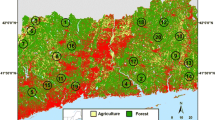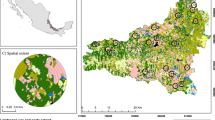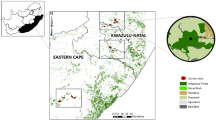Abstract
Landscape metrics are widely applied in landscape ecology to quantify landscape structure. However, many are poorly tested and require rigorous validation if they are to serve as reliable indicators of habitat loss and frag-mentation, such as Montreal Process Indicator 1.1e. We apply a landscape ecology theory, supported by explor-atory and confirmatory statistical techniques, to empirically test landscape metrics for reporting Montreal Process Indicator 1.1e in continuous dry eucalypt forests of sub-tropical Queensland, Australia. Target biota examined included: the Yellow-bellied Glider (Petaurus australis); the diversity of nectar and sap feeding glider species including P. australis, the Sugar Glider P. breviceps, the Squirrel Glider P. norfolcensis, and the Feathertail GliderAcrobates pygmaeus; six diurnal forest birds species; total diurnal bird species diversity; and the density of nec-tar-feeding diurnal bird species. Two scales of influence were considered: the stand-scale (2 ha), and a series of radial landscape extents (500 m –2 km;78–1250 ha) surrounding each fauna transect. For all biota, stand-scale structural and compositional attributes were found to be more influential than landscape metrics. For the Yellow-belliedGlider, the proportion of trace habitats with a residual element of old spotted-gum/ironbark eucalypt trees was a significant landscape metric at the 2 km landscape extent. This is a measure of habitat loss rather than habitat fragmentation. For the diversity of nectar and sap feeding glider species, the proportion of trace habitats with a high coefficient of variation in patch size at the 750 m extent was a significant landscape metric. None of the landscape metrics tested was important for diurnal forest birds. We conclude that no single landscape metricadequately captures the response of the region’s forest biota per se. This poses a major challenge to regional reporting of Montreal Process Indicator 1.1e, fragmentation of forest types.
Similar content being viewed by others
References
Addicott J.F., Aho J.M., Antolin M.F., Padilla D.K., Richardson J.S. and Soluk D.A. 1987.Ecological neighbourhoods: scaling environmental patterns. Oikos 49: 340–346.
Akaike H. 1973. Information theory and an extension of the maximum likelihood principle. In: Petrov B. and Csaki F. (eds), Second international symposium on information theory. Budapest, Hungary, pp. 267–281.
Akaike H. 1985. Prediction and entropy. In: Atkinson A. and Fienburg S. (eds), Celebration of statistics: the ISI centenary volume. Springer-Verlag, New York, New York, USA, pp. 1–24.
Anon 1995. Criteria and indicators for the conservation and sustainable management of temperate and boreal forests. The Montreal Process. Canadian Forest Service, Quebec, Canada.
Belbin L. 1995. PATN Pattern Analysis Package: Technical reference manual. Division of Wildlife and Ecology, CSIRO, Canberra, Australia.
Belbin L., Faith D.P. and Milligan G.W. 1992. A comparison of two approaches to flexible clustering. Multivariate Behavioural Research 27: 417–433.
Bissonette J.A. 1997. Scale sensitive ecological properties: historical context, current meaning. In: Bissonette J.A. (ed.), Wildlife and landscape ecology: effects of pattern and scale. Springer-Verlag, New York, New York, USA, pp. 3–31.
Brand D.G. 1997. Criteria and indicators for the conservation and sustainable management of forests: progress to date and future directions. Biomass and Bioenergy 13: 247–253.
Bunnell F.L. 1997. Operational criteria for sustainable forestry: focussing on the essence. The Forestry Chronicle 73: 679–684.
Cale P.G. and Hobbs R.J. 1994. Landscape heterogeneity indices: problems of scale and applicability, with particular reference to animal habitat description. Pacific Conservation Biology 1: 183–193.
Catterall C.P., Driscoll P.V., Hulsman K., Muir D. and Taplin A. (eds) 1993. Birds and their habitats: status and conservation in Queensland. Queensland Ornithological Society, Brisbane, Queensland, Australia, 210 pp.
Catterall C.P., Kingston M.B. and Park K. 1997. Use of remnant forest habitat by birds during winter in subtropical Australia: patterns and processes. Pacific Conservation Biology 3: 262–274.
Commonwealth of Australia 1998. A framework of regional (subnational) level criteria and indicators of sustainable forest management in Australia. Montreal Process Implementation Group (MIG). Department of Primary Industries and Energy, Canberra, Australia, 108 pp.
Digby P.G. and Kempton R.A. 1987. Multivariate analysis of ecological communities. Chapman and Hall, London, UK.
Dunning J.B., Danielson B.J. and Pulliman H.R. 1992. Ecological processes that affect populations in complex landscapes. Oikos 65: 169–175.
Eyre T.J. and Smith A.P. 1997. Floristic and structural habitat preferences of yellow-bellied gliders (Petaurus australis) and selective logging impacts in southeast Queensland, Australia. Forest Ecology and Management 98: 281–295.
Eyre T.J., Krieger G., Venz M., Haseler M., Hines B., Hannah D. et al. 1998. Systematic vertebrate fauna survey project report. Forest Assessment Unit, Department of Environment, Brisbane, Queensland, Australia, 102 pp.
Fahrig L. 1997. Relative affects of habitat loss and fragmentation on population extinction. Journal of Wildlife Management 61: 603–610.
Fahrig L. 1999a. Forest loss and fragmentation: which has the greater effect on persistence of forest-dwelling animals? In: Rochelle J., Lehmann L. and Wisniewski J. (eds), Forest fragmentation: wildlife and management implications. Brill, Lieden, The Netherlands, pp. 87–95.
Fahrig L. 1999b. When is a landscape perspective important? In: Wiens J.A. and Moss M.R. (eds), Issues in landscape ecology. University of Guelph, Ontario, Canada and International Association of Landscape Ecology, pp. 145–147.
Fahrig L. 2001. How much habitat is enough? Biological Conservation 100: 65–74.
Florence R.G. 1996. Ecology and silviculture of eucalypt forests. CSIRO Publishing, Melbourne, Australia, 413 pp.
Franklin J.F. and Forman R.T.T. 1987. Creating landscape patterns by forest cutting: Ecological consequences and principles. Landscape Ecology 1: 5–18.
Garman S.L., Swanson F.J. and Spies T.A. 1999. Past, present, and the future landscape patterns in the Douglas-fir region of the Pacific Northwest. In: Rochelle J.A., Lehmann L.A. and Wisniewski J. (eds), Forest fragmentation: wildlife and management implications. Brill, Leiden, The Netherlands, pp. 61–86.
Goldingay R.G. and Kavanagh R.P. 1991. The Yellow-bellied glider: a review of its ecology and management considerations. In: Lunney D. (ed.), Conservation of Australia’s forest fauna. Surrey Beatty and Sons, Sydney, Australia, pp. 365–375.
Goldingay R.L. 1991. An evaluation of hypotheses to explain the pattern of sap feeding by the yellow-bellied glider, Petaurus australis. Australian Journal of Ecology: 491–500.
Grimes R.F. and Pegg R.E. 1979. Growth data for spotted-gumironbark forests in South-east Queensland. Technical Paper WO. 17. Department of Forestry, Brisbane, Queensland, Australia.
Haines-Young R.H. and Chopping M. 1996. Quantifying landscape structure: a review of landscape indices and their application to forested environment. Progress in Physical Geography 20: 418–445.
Hansen A.J. and di Castri F. 1992. Landscape boundaries: consequences for biodiversity and ecological flows. Springer-Verlag, New York, New York, USA.
Hargis C.D., Bissonette J.A. and David J.L. 1998. The behaviour of landscape metrics commonly used in the study of habitat fragmentation. Landscape Ecology 13: 167–186.
Hobbs R.J. 1999. Clark Kent or superman: Where is the phone booth for landscape ecology? In: Klopatek J.M. and Gardner R.H. (eds), Landscape ecological analysis: issues and applications. Springer, New York, New York, USA, pp. 11–23.
Johnston R.J. 1986. Multivariate statistical analysis in geography. Longman Group, Harlow, UK, 280 pp.
Jolliffe I.T. 1986. Principal component analysis. Springer-Verlag, New York, New York, USA, 271 pp.
Kenny D.A. 1979. Correlation and causality. John Wiley, New York, New York, USA, 277 pp.
King A.W. 1997. Hierarchy theory: a guide to system structure for wildlife biologists. In: Bissonette J. (ed.), Wildlife and landscape ecology. Springer-Verlag, New York, New York, USA, pp. 185–212.
Kolasa J. and Rollo C.D. 1991. Introduction: the heterogeneity of heterogeneity (a glossary). In: Kolasa J. and Pickett S. (eds), Ecological heterogeneity. Springer-Verlag, New York, New York, USA, pp. 1–23.
Kotliar N.B. and Wiens J.A. 1990. Multiple scales of patchiness and patch structure: a hierarchical framework for the study of heterogeneity. Oikos 59: 253–260.
Laurance W.F. and Bierregaarde R.O. (eds) 1997. Tropical forest remnants: ecology, management and conservation of fragmented communities. University of Chicago Press, Chicago, Illinois, USA, 616 pp.
Li C.C. 1975. Path Analysis-a primer. Boxwood, California, USA, 347 pp.
Lindenmayer D.B. and Cunningham R.B. 1997. Patterns of co-occurrence among arboreal marsupials in the forests of central Victoria, south-eastern Australia. Australian. Journal of Ecology: 340–346.
Lindenmayer D.B., Cunningham R.B. and McCarthy M.A. 1999a. The conservation of arboreal marsupials in the montane ash forests of the central highlands of Victoria, southeastern Australia. VIII. Landscape analysis of the occurrence of arboreal marsupials. Biological Conservation 89: 83–92.
Lindenmayer D.B., Cunningham R.B. and Pope M.L. 1999b. A large-scale “experiment” to examine the effects of landscape context and habitat fragmentation on mammals. Biological Conservation 88: 387–403.
Lindenmayer D.B., Cunningham R.B., Donnelly C.F. and Lesslie R. 2002. On the use of landscape surrogates as ecological indicators in fragmented forests. Forest Ecology and Management 159: 203–216.
Loyn R.H. and McAlpine C.A. 2001. Spatial patterns and fragmentation: Indicators for conserving biodiversity in forest landscapes. In: Raison R., Brown A. and Flinn D. (eds), Criteria and indicators for sustainable forest management. CAB International, Wallingford, UK, pp. 391–422.
McAlpine C.A., Grigg G.C., Mott J.J. and Sharma P. 1999. The influence of landscape structure on kangaroo abundance in disturbed semi-arid woodland of Queensland. The Rangeland Journal 15: 104–134.
McAlpine C.A., Scarth P., Phinn S.P. and Eyre T.J. 2002a. Mapping glider habitat in dry eucalypt forests for Montreal Process Indicator 1.1e, Fragmentation of forest types. Australian Forestry 64: 232–241.
McAlpine C.A., Fensham R.J. and Temple-Smith D.E. 2002b. Biodiversity conservation and vegetation clearing in Queensland: principles and thresholds. The Rangeland Journal 24 (in press).
McDonald R.P. and Marsh H.W. 1990. Choosing a multivariate model: noncentrality and goodness of fit. Psychological Bulletin 107: 247–255.
McGarigal K. and Marks B.J. 1994. Fragstats. Spatial pattern analysis program for quantifying landscape structure. Version 2.0. Forest Science Department, Oregon State University, Corvallis, Oregon, USA.
McGarigal K. and McComb W.C. 1995. Relationships between landscape structure and breeding birds in the Oregon Coast Range. Ecological Monographs 65: 235–260.
McIntyre S. and Barrett G.W. 1992. Habitat variegation, an alternative to fragmentation. Conservation Biology 6: 146–147.
Noss R.F. 1999. Assessing and monitoring forest biodiversity: A suggested framework of indicators. Forest Ecology and Management 115: 135–146.
Prabhu R., Ruitenbeek H.J., Boyle T.J.B. and Pierce Colfer C.J. 2001. Between voodoo science and adaptive management: the role of research needs for indicators of sustainable forest management. In: Raison R., Brown A. and Flinn D. (eds), Criteria and indicators for sustainable forest management. CAB International, Wallingford, UK, pp. 39–66.
Queensland Department of Natural and Resources 1998. Sustainable forest management technical report: old-growth forest in Southeast Queensland. Queensland Department of Natural Resources, Brisbane, Queensland, Australia.
Riitters K.H., O’Neill R.V., Hunsaker C.T. and Wickham J.D. 1995. A factor analysis of landscape pattern and structure metrics. Landscape Ecology 10: 23–39.
Rochelle J.A., Lehmann L.A. and Wisniewski J. (eds) 1999. Forest fragmentation: Wildlife and management implications. Brill, Leiden, The Netherlands.
Scarth P., Phinn S.R. and McAlpine C.A. 2001. Integrating high and moderate spatial resolution image data for mapping forest age structure. Canadian Journal of Remote Sensing 27: 129–142.
Shipley B. 2000. Cause and correlation in biology: A user’s guide to path analysis, structural equations and causal inference. Cambridge University Press, Cambridge, UK.
Smith A. and Hume I. (eds) 1984. Possums and gliders. Surrey Beatty and Sons Pty Ltd, Sydney, Australia, 598 pp.
Sörbom D. and Jöreskog K.G. 1992. The use of structural equation models in evaluation research. In: Fornell C. (ed.), A second generation of multivariate analysis: measurement and evaluation. Praeger, New York, New York, USA, pp. 341–418.
Statsoft 1995. STATISTICA for Windows. Statsoft Inc., Tulsa, Oklahoma, USA.
Steiger J.H. 1995. Structural equation modelling. STATISTICA for Windows. Stastoft Inc., Tulsa, Oklahoma, USA.
Tabachnich B.G. and Fidell L.S. 2001. Using multivariate statistics. 3rd edn. Harper Collins, New York, New York, USA, 880 pp.
Tanaka J.S. and Huba G.J. 1989. A general coefficient of determination for covariance structure models under arbitrary GLS estimation. British Journal of Mathematical and Statistical Psychology 42: 233–239.
Tilman D., May R.M., Lehman C. and Nowak M.A. 1994. Habitat destruction and the extinction debt. Nature 371: 65–66.
Wiens J.A. 1994. Habitat fragmentation: island v landscape perspectives on bird conservation. Ibis 137: 97–104.
Wiens J.A. 1995. Landscape mosaics and ecological theory. In: Hansonn L., Fahrig L. and Merriam G. (eds), Mosaic landscapes and ecological processes. Chapman and Hall, London, UK, pp. 1–26.
Author information
Authors and Affiliations
Rights and permissions
About this article
Cite this article
McAlpine, C.A., Eyre, T.J. Testing landscape metrics as indicators of habitat loss and fragmentation in continuous eucalypt forests (Queensland, Australia). Landscape Ecol 17, 711–728 (2002). https://doi.org/10.1023/A:1022902907827
Issue Date:
DOI: https://doi.org/10.1023/A:1022902907827




